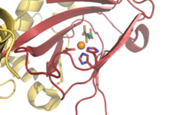Antibiotics
Antibiotics: Biosynthesis and Resistance Mechanisms
Antibiotic Biosynthesis
Most clinically used antibiotics are based upon natural products. The most important family of antibiotics contains a β-lactam ring, and includes the penicillin, cephalosporin, clavam, and carbapenem antibiotics. Our recent biosynthetic work has focused on the clavams and carbapenems, with a particular focus being on the mechanism and structures of enzymes that catalyse chemically 'interesting' steps. One of the clavams, clavulanic acid, is the most important clinically used β-lactamase inhibitor and like the penicillins and cephalosporins is produced by fermentation. This method has limited the production of modified clavams with improved clinical properties. In contrast the carbapenems are produced by total synthesis as it has not yet been possible to develop a viable commercially fermentation route to the clinically used antibiotics. We are interested in studying the biosynthetic pathways to the clavams and carbapenems with a view to developing routes to improved antibiotics and because the pathways involve some remarkable reactions from a chemical perspective.
Clavulanic Acid Mode of Action and Biosynthesis
β-Lactamases, which catalyse hydrolysis of the β-lactam ring, are amongst the most important mediators of antibiotic resistance and some β-lactams, including clavulanic acid, were explicitly developed as β-lactamase antagonists. Clavulanic acid inhibits Class A β-Lactamases by reacting to form acyl-enzyme complexes that are stable with respect to hydrolysis, a process closely related to the mode of action of β-lactam antibiotics such as the penicillins that inhibit transpeptidases involved in cell wall biosynthesis.
Although clavulanic acid is a small molecule (C8H8NO5) and contains only two chiral centres it is thermodynamically unstable and it has not been made via asymmetric total synthesis. We are investigating the biosynthetic pathway to clavulanic acid - our work involves structural work, functional analyses, and mechanistic studies. Techniques involved in this research include molecular biology, X-ray crystallography kinetics and organic synthesis. The latter is important since the late stage intermediates in the pathway are difficult to prepare and unstable. Studies on the multistep pathway (in collaboration with Inger Andersson and Janos Hajdu) have led to surprises including the trifunctional role of a single oxygenase and the fact that the pathway proceeds via intermediates that are almost enantiomers of the final product.
Recent work on the pathway has found proteins involved in the transport of intermediates and enzymes that catalyse reactions via acyl-enzyme intermediates.
Carbapenem Biosynthesis
The biosynthesis of carbapenem-5-carboxylate provides a model to understand the biosynthesis of the clinically useful carbapenem Thienamycin, an antibiotic more potent than most penicillins. In contrast to clavulanic acid biosynthesis, that of the simplest carbapenem requires only three steps - all of which we are presently investigating. The first enzyme CarB is an unusual member of the crotonase superfamily, the second CarA is a synthetase that in effect catalyses a reverse β-lactamase reaction, and the third CarC catalyses an unprecedented epimerisastion reaction.
In recent work we have been studying the structure and mechanism of CarB - a particular focus being on controlling the reactivity of the enolate intermediate in CarB catalysis. An ultimate goal would be enable the development of biocatalysts that can generate products of choice to react them with stereoselectivity with a range of electrophiles.
Antibiotic Mode of Action/Resistance
The biggest threats to the continued use of β-lactam antibiotics, including the penicillins and cephalosporins, is that of bacterial resistance. In collaboration with partners in the European Intafar Project we are presently investigating new types of antibiotic that target penicillin binding proteins that are resistant to β-lactams such as penicillins. We are also working on the design and synthesis of inhibitors for the metallo β-lactamases - there are no clinically used inhibitor of these enzymes but they pose a significant threat as they catalyse the hydrolysis of almost all clinically used β-lactam antibiotics.
Our projects involve close collaboration between synthetic chemists, structural biologists/ modelers and biologists. Current research includes new template identification using high throughput screening, structure- and fragment- based design, inhibitor synthesis based on in silico results, and the synthesis of analogues and derivatives of natural product based antibiotics.
In recent work we have investigated the mechanism of action of Lactivicin, the only naturally occurring non β-lactam compound to target penicillin binding proteins, by synthesising analogues and carrying out crystallographic studies. Derivatives of Lactivicin show promise against penicillin resistant strains. We have also been developing new types of penicillin binding protein inhibitor, that bind irreversibly, with a particular focus being on boronic acids.



